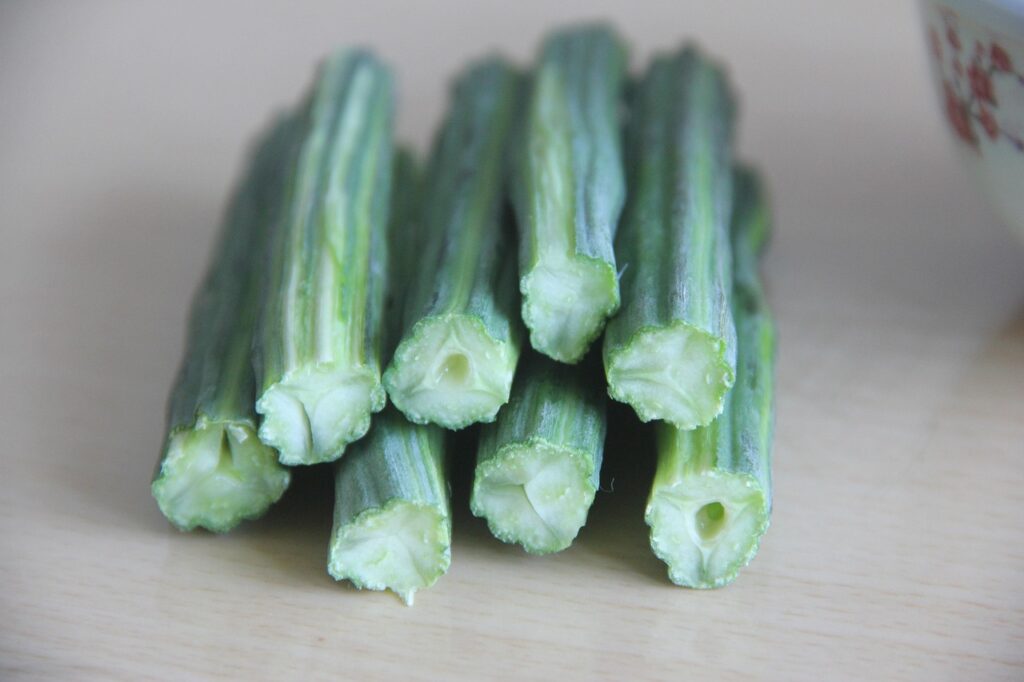
Drumsticks, also known as Moringa, are highly nutritious and offer numerous health benefits. Some of the key benefits include:
Rich in Nutrients: Drumsticks are packed with essential vitamins and minerals such as vitamin C, vitamin A, calcium, potassium, and iron. They are also rich in protein and antioxidants.
Anti-Inflammatory Properties: Moringa has potent anti-inflammatory properties, which can help reduce inflammation in the body, benefiting conditions like arthritis and other inflammatory diseases.
Supports Heart Health: The high levels of antioxidants and anti-inflammatory compounds in drumsticks contribute to lowering blood pressure and cholesterol levels, promoting better heart health.
Boosts Immunity: The vitamin C content in drumsticks helps in strengthening the immune system, protecting against common colds, infections, and other illnesses.
Improves Digestion: Drumsticks are rich in fiber, which promotes healthy digestion, relieves constipation, and supports gut health.
Blood Sugar Regulation: Some studies suggest that drumsticks may help in lowering blood sugar levels, making them beneficial for people with diabetes or those at risk of developing it.
Promotes Skin Health: The antioxidants and vitamin C in drumsticks help improve skin elasticity, fight oxidative stress, and reduce signs of aging.
Enhances Liver Function: Drumsticks contain compounds that may protect the liver from damage and support its detoxification processes.
Boosts Energy Levels: Due to their high nutrient content, including B vitamins and iron, drumsticks can help combat fatigue and improve overall energy levels.
Incorporating drumsticks into your diet can be an excellent way to boost overall health and prevent nutrient deficiencies.
Climate that supports Moringa tree’s growth
Drumsticks, or Moringa trees, thrive in tropical and subtropical climates. They prefer warm temperatures and are well-suited to areas with:
High temperatures: Moringa grows best in temperatures ranging from 25°C to 35°C (77°F to 95°F).
Well-drained soil: The trees prefer dry, sandy, or loamy soil that is well-drained. While they can tolerate drought conditions, they don’t do well in waterlogged soils.
Minimal frost: Moringa trees are sensitive to frost, and they cannot survive in cold temperatures. They grow best in regions that do not experience freezing temperatures.
These trees are commonly found in countries such as India, Africa, Southeast Asia, and parts of South America, where the climate supports their growth needs.
Different ways in which drumstick can be eaten
Drumsticks (Moringa pods) are versatile and can be eaten in various ways. Here are some common methods for eating drumsticks:
1. Cooked in Curries or Stews:
Preparation: Peel the outer skin of the drumstick pods, and then break them into smaller pieces. The flesh inside is soft and edible.
Usage: Add the pieces to curries, stews, or soups. The drumsticks absorb the flavors of the dish and add a mild taste.
Tip: Drumsticks are commonly used in Indian cuisine, such as in sambar (a lentil-based curry) and other vegetable curries.
2. Stir-Fried:
Preparation: Cut the drumsticks into smaller chunks and stir-fry them with onions, garlic, and spices.
Usage: Serve as a side dish with rice or flatbread.
3. In Salads:
Preparation: When young and tender, drumsticks can be chopped and added to salads for a crunchy texture.
Tip: You can also boil the tender drumsticks for a few minutes and then mix them into a salad for extra flavor.
4. Pickles:
Preparation: Drumsticks can be preserved as pickles, typically by chopping them into pieces and marinating them in oil, vinegar, and spices.
Usage: Eat as a condiment with meals.
5. Juice or Smoothies:
Moringa Leaves: If you’re referring to the leaves of the Moringa tree, they can be blended into smoothies or juices. Moringa leaves are highly nutritious.
Preparation: You can blend fresh Moringa leaves with fruits, yogurt, or water for a nutritious drink.
6. Boiled and Eaten as a Snack:
Preparation: Simply boil the drumstick pieces in water until tender, then eat them as a snack.
Tip: Add a pinch of salt or seasoning to enhance the flavor.
7. Moringa Powder:
Moringa Powder: If you have Moringa powder (made from dried leaves), it can be added to smoothies, teas, soups, or even sprinkled on food.
Tip: Start with a small amount (1 teaspoon) to avoid strong bitterness.
Drumsticks are a versatile and nutritious ingredient. The young, tender pods and leaves are the most commonly eaten parts, while the older pods are used in cooked dishes for their flavor.
